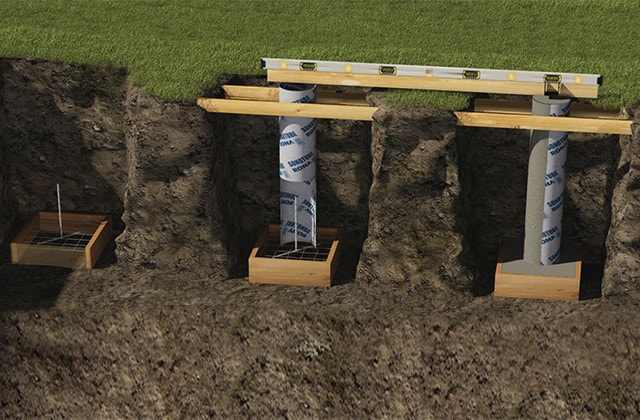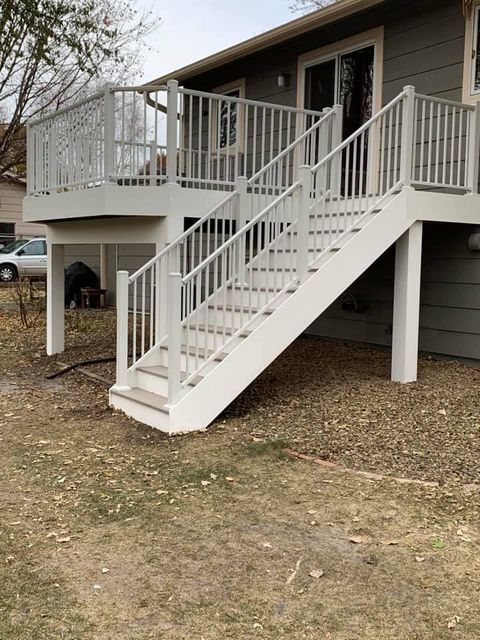Architectural Honesty Issues: Picking the Right Deck Footings for Your Outdoor Task
Professional Tips for Installing Deck Footings to Support Your Outdoor Space
When it concerns constructing a deck, among the most crucial aspects to think about is the setup of correct footings. These footings are the structure upon which your outdoor space will relax, offering stability and support for years ahead. But exactly what does it require to install deck grounds properly? In this conversation, we will discover professional tips and methods that can help guarantee a sturdy and effective deck setup. From selecting the best kind of grounds to preventing common blunders, we will certainly give you with the expertise and understandings you require to with confidence get started on your deck-building trip. Allow's dive right in and find the key to a long-lasting and strong outside space.
Relevance of Appropriate Deck Grounds
Proper deck grounds are essential for making certain the stability and long life of your exterior space. Without strong and correctly mounted grounds, your deck may end up being unsteady, leading to safety risks and costly repair services.

Along with stability, proper deck grounds also add to the longevity of your outdoor area (Deck Footings). Footings that are made and constructed to hold up against the aspects and soil conditions in your location will aid stop the deck from clearing up or shifting gradually. By guaranteeing the footings are appropriately sized and mounted, you can reduce the threat of damage to the deck structure, extending its lifespan and decreasing the requirement for expensive fixings or substitutes

Picking the Right Kind of Footings
When picking the appropriate kind of footings for your deck, it is necessary to consider variables such as soil conditions, neighborhood building regulations, and the general layout of your outdoor space. The kind of footing you pick will certainly play an essential function in making sure the security and long life of your deck.
One typical type of footing is the concrete ground. Concrete footings are appropriate for the majority of dirt problems and provide superb support for decks. They are typically mounted below the frost line to avoid changing and resolving because of cold and thawing cycles. Another alternative is helical piers, which are excellent for areas with unpredictable soil or high water tables. These piers are screwed into the ground and provide strong assistance for the deck.
In many cases, you might require to make use of specialized grounds, such as heap grounds or deep foundations, if you are building a huge or multi-level deck. These grounds are designed to disperse the weight of the deck over a larger area, ensuring stability and stopping sinking or resolving.
Before selecting a sort of ground, it is vital to seek advice from regional structure codes and policies to make sure conformity. Furthermore, take into consideration the style and intended usage of your exterior space. Variables such as the size, form, and load-bearing requirements of your deck will certainly influence the kind of footing that is most ideal.
Preparing the Ground for Footing Setup
To appropriately prepare the ground for footing setup, it is essential to assess the soil problems and take essential actions to guarantee stability and resilience of the deck. The very first step is to excavate the area where the footings will be set up.
Once the area has been excavated, the next step is to compact the soil. This can be done using a plate compactor or by making use of a hand tamper. Compacting the soil assists to eliminate any type of voids or air pockets, which can bring about resolving and instability in time.
After condensing the dirt, it is essential to lay a layer of gravel or crushed rock at the bottom of visit the excavation. This will offer drainage and assistance to prevent water from merging around the footings, which can bring about erosion and instability.
Step-by-Step Guide to Installing Deck Footings
After effectively preparing the ground for footing installment, the following action is to start the process of mounting deck grounds. This detailed overview will certainly supply you with a clear understanding of how to install deck grounds for your exterior space.
Identify the place: Start by marking the settings of the deck grounds using stakes and string. Ensure that the places straighten with the style and design of your deck.
Dig the openings: Make use of an article hole digger or an auger to dig the holes for the grounds. The deepness and diameter of the openings should remain in accordance with local building regulations and the specific needs of your deck layout.
Level the openings: Use a degree to make certain that the openings are dug to the proper depth and are degree with each other. (Deck Footings)
Add crushed rock: Place a layer of gravel at the base of each hole to improve drain and avoid the wood from rotting.
Put the footings: Position the grounds into the holes, ensuring they are level and plumb. Make use of a level and a determining tape to make certain accuracy.
Protect the footings: Put concrete into the openings around the footings, loading them to the top. Make use of a post degree to ensure the grounds remain degree as the concrete sets.
Enable time for healing: Allow the concrete remedy according to the supplier's instructions prior to proceeding with the deck construction.
Usual Errors to Avoid Throughout Footing Setup
One crucial facet to consider during the setup of deck grounds is preventing typical mistakes that can jeopardize the stability and click to investigate durability of your outdoor space. While deck grounds might seem like a easy and simple component of the construction process, neglecting certain elements can cause costly fixings and possible safety threats down the line.

In addition, neglecting to install proper water drainage actions can cause water to gather around the footings, bring about rot, degeneration, and the eventual weakening of the deck's foundation. Additionally, making use of the wrong type of footing material or stopping working to sufficiently safeguard the footings can jeopardize their architectural stability.
To stay clear of these mistakes, it is necessary to seek advice from a specialist or follow industry guidelines to make sure proper ground installment. By doing so, you can make certain the security and longevity of your outdoor space, providing a enjoyable and safe setting for many years to find.
Conclusion
To conclude, mounting appropriate deck footings is crucial for the security and durability of your outside area. By choosing the ideal kind of grounds and properly preparing the ground, you can guarantee a strong structure for your deck. Adhering to a detailed overview and avoiding usual mistakes during footing installation will additionally boost the durability and security of your deck.
Appropriate deck grounds are necessary for making certain the security and longevity of your outside space. The grounds offer as a connection between the ground and the deck, allowing the weight of the deck and its owners to be spread uniformly right into the dirt.One usual kind of ground is the concrete footing. Place the click to find out more footings: Put the footings right into the openings, making certain they are degree and plumb. Safeguard the grounds: Pour concrete into the holes around the grounds, loading them to the top.